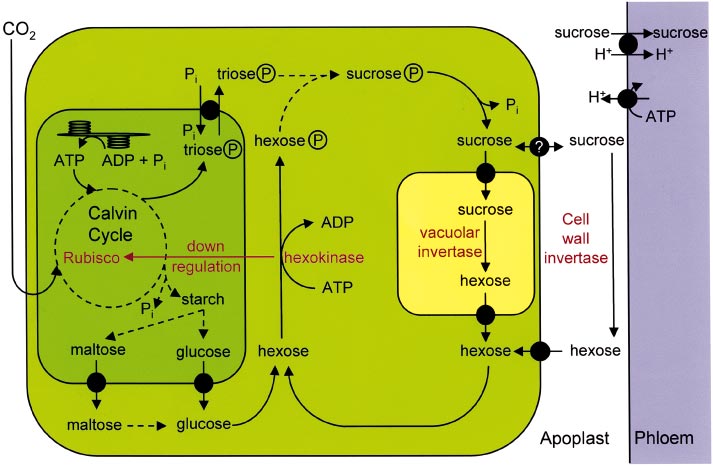Introduction
Imagine if the air you breathe started changing in ways that fundamentally altered how your body functions. For plants, this is the reality they face with rising levels of atmospheric carbon dioxide (CO₂), a situation unseen for the past 26 million years[1]. Let's explore how plants are adapting to this significant change through a fascinating technology called Free-Air CO₂ Enrichment (FACE).
Understanding Short-Term Plant Responses to Elevated CO₂
Increased Photosynthesis and Water Efficiency
When exposed to higher CO₂ levels, terrestrial plants using the C₃ photosynthetic pathway initially boost their net photosynthesis and reduce transpiration[1]. This happens because the enzyme Rubisco, which is key to fixing carbon during photosynthesis, works more efficiently at higher CO₂ concentrations. Plus, CO₂ inhibits a wasteful process called photorespiration, making the plant's energy use more efficient[1].
![None title: 'Figure 2 Schematic of the direct initial effects of rising [CO2] on C3 plant production. Increased [CO2] increases the rate of carboxylation at Rubisco while inhibiting the oxygenation reaction and thus decreasing photorespiratory loss of carbon. Increased production allows increased leaf area development, providing positive feedback on the plant photosynthetic rate. This is further reinforced by decreased transpiration and improved leaf water status, which also favor increased leaf area growth.'](https://askpandipro.s3.amazonaws.com/users/1/documents/102/figures/0.jpeg?AWSAccessKeyId=AKIAQT4QH3CHNPX5WHX7&Signature=fHkIljdCM%2B3vaxGQf8bfUC7KCpw%3D&Expires=1764886675)
Additionally, the stomata (tiny openings on leaves) partially close, decreasing water loss without significantly reducing CO₂ intake[1]. This improved water use efficiency is a big deal, especially for areas prone to drought.
Rubisco and Stomatal Adjustments
Despite these immediate benefits, plants undergo adjustments. While increased CO₂ boosts photosynthetic rates by improving Rubisco's efficiency, the exact mechanism for stomatal response to CO₂ is less clear but seems linked to overall photosynthetic activity[1].
Long-Term Responses and Downregulation
While plants see a short-term boost in photosynthesis from high CO₂, over time, this is often balanced by a phenomenon called downregulation, where plants slightly reduce their photosynthetic capacity. This typically involves a decrease in Rubisco levels[1]. This is not just a lab artifact but has been observed in the field through FACE experiments[1].
Free-Air CO₂ Enrichment (FACE): The Game Changer
![None title: 'Figure 5 One of 16 FACE rings within a soybean crop at the University of Illinois SoyFACE facility (5, 175). CO2 is released into the wind under high pressure from nozzles in the green pipe. Release is always on the upwind side of the ring and the release rate governed by the wind speed and [CO2] is measured at the center of the ring. The lower right panel shows an example from a test ring of controlled elevation over a 16-h period. The lower left panel shows a thermal image of part of the ring shown above. Elevation of [CO2] decreases stomatal conductance and transpiration; consequently, the vegetation within the ring is significantly warmer. This image also provides graphical illustration that the elevation is relatively uniform (pictures couresy of Andrew Leakey, Tim Mies & Hans Bohnert).'](https://askpandipro.s3.amazonaws.com/users/1/documents/102/figures/5.jpeg?AWSAccessKeyId=AKIAQT4QH3CHNPX5WHX7&Signature=E%2FSl8P8HDEs1MjBFB9AcVEjL2QE%3D&Expires=1764886675)
FACE allows scientists to grow plants in open fields under controlled elevated CO₂, closely mimicking natural conditions[1]. This technology eliminates many limitations of greenhouse or chamber studies, providing more accurate insights into how plants truly respond to high CO₂ levels. FACE experiments have been critical in understanding these long-term plant responses.
Findings from FACE Experiments
Studies have summarized the results from multiple FACE experiments, covering a wide range of plants and conditions. These experiments revealed sustained increases in photosynthesis (about 30%) and a decrease in plant water use (due to reduced stomatal conductance by about 20%)[1]. Importantly, these increases in efficiency and growth do not seem to taper off even after long-term exposure, contradicting earlier fears of transient benefits[1].

Face studies also showed an interesting aspect of plant adaptation: While Rubisco content decreased by around 20%, it did not affect the plants' photosynthetic capacity at elevated CO₂ levels. This suggests plants are becoming more efficient in using their resources[1].
Unexpected Findings: C₄ Photosynthesis and Stomatal Acclimation
C₄ plants, which already use CO₂ more efficiently, also showed a 10% increase in photosynthesis under elevated CO₂, primarily due to improved water status rather than intrinsic photosynthetic changes[1]. This finding challenges the previous assumption that C₄ plants wouldn't benefit much from higher CO₂ levels.
Interestingly, while C₃ plants showed a significant drop in stomatal conductance, maintaining a constant internal to external CO₂ ratio (ci/ca), C₄ plants didn't show the same degree of stomatal response, highlighting species-specific differences in adaptation strategies[1].
Implications for Future Agriculture and Ecosystems
The comprehensive data from FACE studies suggest that plant responses to rising atmospheric CO₂ will significantly impact agriculture and natural ecosystems. For instance, the 20% increase in dry matter production and 24% gain in seed yield for C₃ crops can significantly benefit food security[1]. Conversely, the unchanged Leaf Area Index (LAI) suggests that future models predicting increased vegetative cover might need revision[1].
Moreover, the enhanced water use efficiency across plant types could mitigate drought impacts, stabilizing yields in arid regions. Also, changes in leaf nutrient content, particularly decreased nitrogen and protein levels, could affect food quality and ecosystem nutrient cycles[1].
Conclusion
Face technology has provided invaluable insights into how plants might respond to the ongoing rise in atmospheric CO₂. While there are immediate benefits like increased photosynthesis and water-use efficiency, plants also make long-term adjustments to optimize resource use. These findings are crucial for predicting future agricultural productivity and ecological shifts, helping us navigate the challenges of a changing atmosphere.

Understanding these processes ensures that we are better prepared to manage and adapt agricultural practices, ensuring food security and ecosystem health for future generations.
Get more accurate answers with Super Pandi, upload files, personalized discovery feed, save searches and contribute to the PandiPedia.
Let's look at alternatives:
- Modify the query.
- Start a new thread.
- Remove sources (if manually added).